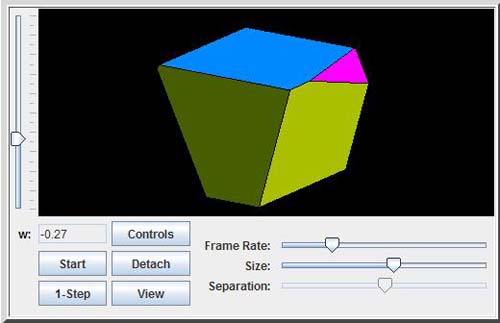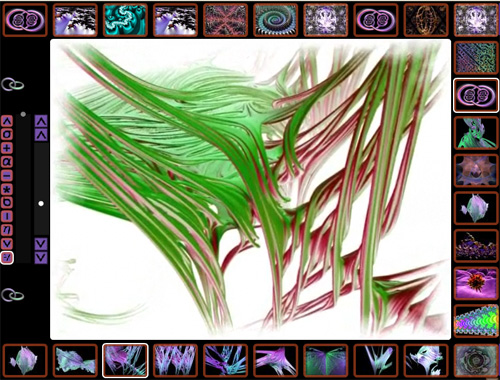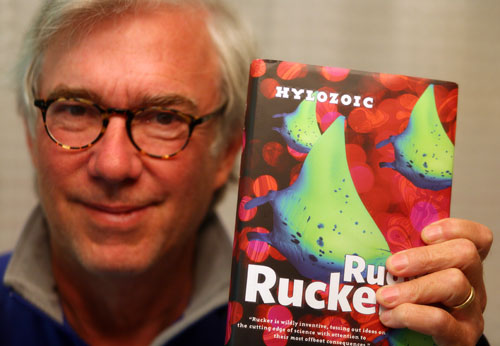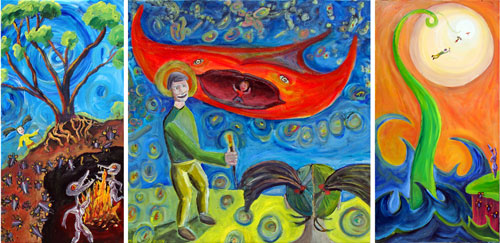25 Boing Boing Posts, May, 2009
I was a guestblogger at BoingBoing from May 18 – May 31, 2009, putting up twenty-five posts, which got 735 comments as of May 31, with a few more comments still trickling in.
Lest eventual bitrot obliterate my posts, I’m saving them (without the comments) on this page on my own site.
(The originals, with comments, used to be on the Guestblog archive at BoingBoing—but that link’s dead now, you’d need to seek out an Internet backup site to see it.)
==========
#1 Gnarly Plotting
(Posted on May 18, 2009)

(Rudy Rucker is a guestblogger. His latest novel, Hylozoic, describes a postsingular world in which everything is alive.)
I love gnarly shapes and processes—gnarly in the sense of being not too orderly and not too random, right on the living border. Moving water is amazing stuff, and cranking your camera’s shutter speed up high lets you freeze it. And your foot, every now and then you look at it and—how strange. Really, we’re as oddly shaped as any fabulous jungle plant or deep ocean crustacean.
A few years ago, I gave a talk called “Seek the Gnarl” where I talked about how gnarliness relates to the way a writer creates the plot for a novel.
I used to maintain that it was better not to plot my novels in advance. I’d defend the practice of not having a precise outline by speaking in terms of the gnarl. A characteristic feature of any complex process is that you can’t look at what’s going on today and immediately deduce what will be happening in a few weeks. It’s necessary to have the world run step-by-step through the intervening ticks of time. Gnarly processes are unpredictable; they don’t allow for short-cuts. In other words, the last chapter of a novel with a gnarly plot is, even in principle, unpredictable from the contents of the first chapter. You have to write the whole novel in order to discover what happens in the last chapter.
This said, I’ve learned to at least try to write an outline to try and lessen the pain of writing. But even with an outline, I can’t be quite sure about the twists and turns my story will take. How precise, after all, is an outline? If, as William Burroughs used to say, a novel is but a map of a territory, an outline is but a map of a map. In the end, only the novel itself is the perfect outline of the novel. Only the territory itself can be the perfect map.
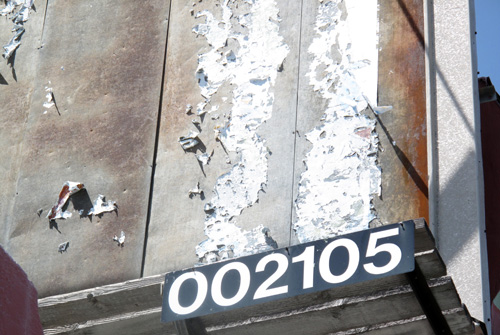
I took this photo on Shattuck Avenue in Berkeley the other day. I like the contrast between the digital numbers labeling the billboard, and the gnarly tatters of the peeling paper. The numbers are the outline, the (actually quite elegant) shapes of the paper are the novel.
I’m not saying a novel should be a random mess. I’m saying that it’s nice if the story has the organic and unpredictable feel of some living thing that’s grown or of some natural shape that’s arisen over time. The characters and tropes and social situations bounce off each other like eddies in a turbulent wakes, like vines twisting around each other in a jungle, like the plates of a skull.
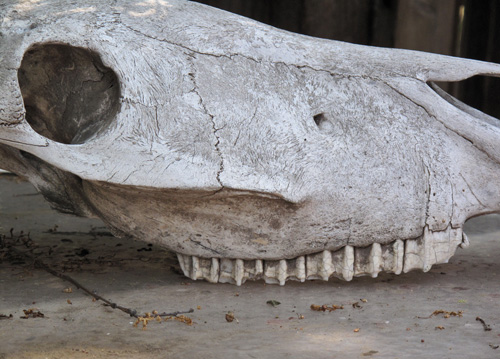
Online version of Rudy’s talk, “Seek the Gnarl”.
===============
#2 Kadrey and Shaw Live
(Posted on May 19, 2009)
(Rudy Rucker is a guestblogger. His latest novel, Hylozoic, describes a postsingular world in which everything is alive.)

I saw Richard Kadrey and Heather Shaw reading at the SF in SF series this weekend.
The readings were good and somewhat cyberpunk/urban-fantasy. Heather read her story “LIttle M@tch Girl,” and Richard read from his Sandman Slim novel, due out in July, 2009.
“Little M@tch Girl,” by the way, exists online, but in the context of incredibly weird zine called Tumbarumba. In order to read the stories in Tumbarumba, you go to their site, download a Firefox add-on, and wait for random story scraps to show up on pages that you’re browsing. If you click on one of the story scraps you get more of the story in question. Not exactly the kind of presentation that most writers would pick! I’m kind of hoping to see “Little M@atch Girl” in an easier-to-access format one of these days…
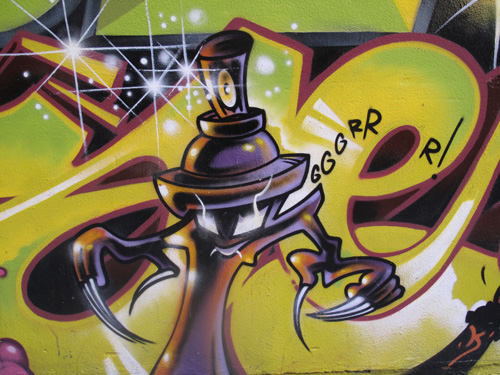
Before the reading we had dinner at a place near this great collaborative graffiti mural at 2nd St. and Minna St. in San Francisco.
I dig that savage alien fire hydrant. "Bad dog!"
==============
#3 Painting and Writing
(Posted on May 19, 2009)
(Rudy Rucker is a guestblogger. His latest novel, Hylozoic, describes a postsingular world in which everything is alive.)

I finished a new painting this week, seemingly just a still life of a geranium—often I paint more surreal kinds of things, as you can see on my paintings site.
With this geranium I did, however, have something extra in mind, that is, I’m working on a kind of urban fantasy/sf novel called Jim and the Flims, and my characters are about to make their way to the castle of the King of Flimsy.

[Somewhat irrelevant picture of a beautiful neon sign.]
I should mention that Flimsy is an alternane world that is, I think, our afterworld, kind of medieval and bucolic—and I had the idea that the castle could look like a giant geranium. Those leaves are thick, you see, with rooms in them, and the flims are buzzing around them like gnats, only too small to see in the painting—that’s the part I need the world processor for!
You can hear me reading a draft of the first chapter of Jim and the Flims at , which you can access by clicking the button below.
As for painting and writing, Charlie Jane Anders has a nice article, "SF Writers Make Art," in the io9 SF site, featuring interviews with SF writers who paint, including me, Audrey Niffenegger, and Mary Robinette Kowal.
===============
#4 Robert Frank Outtakes
(Posted on May 19, 2009)
(Rudy Rucker is a guestblogger. His latest novel, Hylozoic, describes a postsingular world in which everything is alive.)
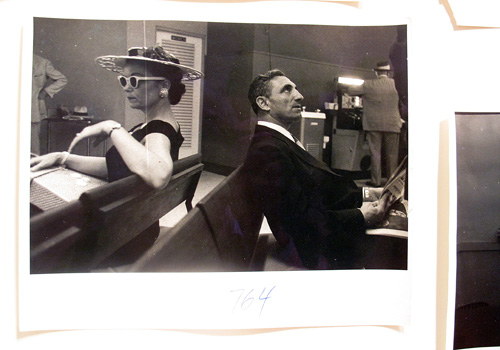
There’s a great show at the SFMOMA now, showing all 84 prints from Robert Frank’s classic mid-1950s photo book The Americans, along with some outtakes, such as the image shown above—which is not in the book.
The reason the image above looks funky is because it’s my photo of Frank’s casual working print that’s glued to a wall at the show with a bunch of others. More outtakes can be found in Looking In, the catalog for the show, which also includes all the prints from The Americans—but I’d say the print quality of the images in the catalog isn’t as good as in the book, although the catalog does have a lot of interesting essays.
I’ve had a copy of The Americans for years, and I study it fairly often. So it was almost dizzying to see the book’s 84 pictures on the walls, in order—it was like getting inside this world at last.
Another cool thing about the show is that they have, like I said, a wall of these working prints of Robert Frank’s outtakes for the book, all curly-edged, as if still in Frank’s studio. He took some 20,000 photos while driving in a huge loop around the US, then printed the 1,000 pictures that he liked best, and then winnowed those down to the final 84.
I grabbed shots of two of the outtakes for this post. I like the waiting-room scene up above, the languid curve of the woman’s hand, and it’s cool that these aren’t models, they’re just people hanging out. Women actually wore hats like that in the 1950s, even in bus-stations!
And the outtake below shows some Buicks getting unloaded and, in the background, on the billboard, a guy with a moose.
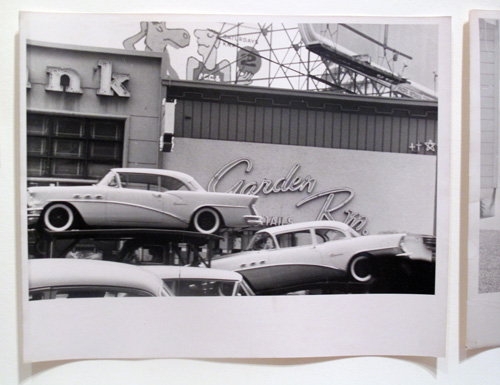
From Jack Kerouac’s introduction to The Americans:
Robert Frank, Swiss, unobtrusive, nice, with that little camera that he raises and snaps with one hand he sucked a big sad oem righ tout of America onto film, taking rank with the tragic poets of the world. To Robert Frank I now give this message: You got eyes.
=========
#5 A Map the Size of the World
(Posted on May 20, 2009)
(Rudy Rucker is a guest blogger. His latest novel, Hylozoic, describes a postsingular world in which everything is alive.)
In the month of my birth, that is, in March, 1946, Jorge Luis Borges co-authored with Adolfo Casares a very short story, “”Del Rigor en la Ciencia,” or “On Exactitude in Science,” about a perfect map that’s as big as the kingdom which it depicts.

Here’s the first half of the story, as translated by Andrew Hurley.
In that Empire, the Art of Cartography attained such Perfection that the map of a single Province occupied the entirety of a City, and the map of the Empire, the entirety of a Province. In time, those Unconscionable Maps no longer satisfied, and the Cartographers Guilds struck a Map of the Empire whose size was that of the Empire, and which coincided point for point with it. The following Generations, who were not so fond of the Study of Cartography as their Forebears had been, saw that that vast Map was Useless…
I also found, how great, a video dramatizing the story’s ideas, with a sound track of Borges himself reading the story in Spanish.
The full text of the translation of “On Exactitude in Science” is online at the Language Scraps ” blog.
And our Universal Library, that is, Wikipedia, has an entry about the Borges story.
==============
#6 Hypercubes
(Posted on May 20, 2009)
(Rudy Rucker is a guestblogger. His latest novel, Hylozoic, describes a postsingular world in which everything is alive.)
Mark Frauenfelder mentioned that the first time he saw me I was carrying a cardboard model of an "unfolded hypercube"—so I rooted around the house and, with my wife’s help, found such a model, this one dates back to 1983.
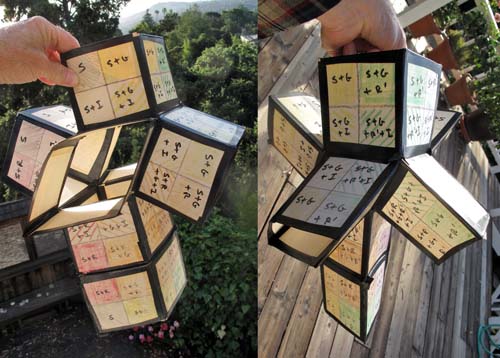
I think it was the hyperdimensional mathematician Tom Banchoff who told me how to make this model. You cut out 28 cardboard squares and tape them, four at a time, to make seven partial cubes. These partial cubes have no tops or bottoms, they’re like square tubes. And then you tape the seven partial cubes together as shown in the photos, making a very cool shape.
[You may notice that the shape is a bit like a hyperdimensional crucifix. Indeed, if I’m not mistaken, the artist Salvador Dali actually consulted with Banchoff when Dali did his well-known painting, Crucifixion (Corpus Hypercubus).]
It’s a universal joint, in that you can swivel the top part freely—which is a little surprising as its all made of straight hinges. To make this into a real hypercube, you’d fold the band of projecting cubes to match the top cube and then—this is the hard part—you "fold" the bottom cube so its faces stretch around the outsides of the other cubes. The Wikipedia Tesseract page has a little animation that helps you visualize how this might work.
The idea behind the coloring on my model is that you start with one corner of the hypercube gray, and you think of the four dimensions as adding the colors red, blue, yellow, and white, coloring the successive 15 corners accordingly. I got the coloring pattern on this model from the early mathematician and science-fictioneer Charles Howard Hinton. In 1980 I edited a book of Hinton’s amazing writings, Speculations on the Fourth Dimension. You can find a lot of this book (minus my introduction) online for free.
The letters on my model have to do with the fact that this particular unfolded hypercube was a gift to my wife on our sixteenth wedding anniversery. Our family members are S, R, G, R’, and I—so you can start with S and think of each of the four dimensions as adding an R, G, R’, and/or I.
One way to study a cube is to slice it into 2D cross-sections, taking the slices at various angles. By the same token, you can study hypershapes by slicing them into 3D cross-sections. Mark Newbold has written a nice Java applet called "HyperSpace Polytope Slicer" that lets you look at 3D cross-sections of four-dimensional shapes (or polytopes) like the hypercube. To use this applet, go to the link and click on the Controls button to get some interactive controls you can play with. Click on View to switch from a double view to a single view. (And better not click on Detach—at least on my machine, that often freezes up the applet.)
If you crave still more hypercube fun, I have two Windows progams written by my Master’s Degree students, available for free download…including a 4D "Hyperspace Invaders" game.
==============
#7 Everything is Alive
(Posted on May 21, 2009)
(Rudy Rucker is a guestblogger. His latest novel, Hylozoic, describes a postsingular world in which everything is alive.)
Over the years, I’ve come to think that everything is alive, even a rock. In academic philosophy, this doctrine is known as "hylozoism"—the word even appears in Wikipedia.

As Stephen Wolfram and I have both pointed out, any gnarly, chaotic natural process embodies a classical universal computation. And at the quantum level, even dull-looking objects are seething with universal quantum computations. When I look at a stone, I think of ten octillion balls connected by springs. There’s a lot going on in a rock, enough to support universal computation, enough to run a mind.
How do I know a rock is alive? If I let go of it, it’s smart enough to drop?
Or maybe, in the right frame of mind, I can feel an affinity to the rock—in a way, there’s no telling where one thing starts and the other thing stops.
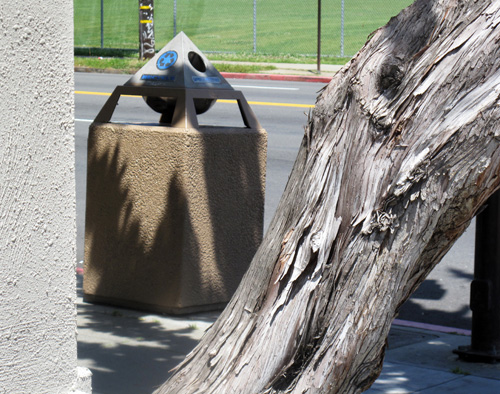
* The text and a video of my "Psipunk" talk about the notion that everything is alive.
* A slightly more academic paper by me, called "Everything is Alive."
===========
#8 Marketing the Minimal
(Posted on May 21, 2009)
(Rudy Rucker is a guestblogger. His latest novel, Hylozoic, describes a postsingular world in which everything is alive.)

How do you market a toy that does almost nothing? Build a gnarly web ad!
We’re talking about the Yo Baby, which is a skateboard with no wheels!
The presence of the turtle in the Yo Baby ad reminds me of Douglas Coupland’s novel, JPod, which is about, among other things, the use of turtles in marketing, and which also has an intricate web page.
==============
#9 Panpsychism and Hylozoism
(Posted on May 22, 2009)
(Rudy Rucker is a guestblogger. His latest novel, Hylozoic, describes a postsingular world in which everything is alive.)
I was happy to see a lot of response to my BoingBoing post of a few days ago, "Everything is Alive." Let me throw a little more fuel on the fire.

[A flowering plant eats a signpost!]
There’s actually two different words we can play with here. "Hylozoism" is the doctrine that everything is alive, while "Panpsychism" is the belief that everything is conscious. These are close in meaning but not quite identical, although I’m comfortable with believing both.
Panpsychism is by no means a wacky new-age concept, it’s been around since the dawn of philosophy. David Skrbina’s fascinating study, Panpsychism in the West, (MIT Press, 2005) maps out the whole history. Here’s a link to a page of Skrbina’s book where he’s discussing one of my favorite panpsychic philosophers, Gustav Theodor Fechner…more about him below.

One funny line from Skrbina, quoting the philosopher Charles Sanders Peirce: "what we call matter is not completely dead, but is merely mind hide-bound with habits."
In discussing hylozoism and panpsychism, we’re not talking about the notion that the universe as a whole is alive and conscious. We’re concerned with viewing individual object, even atoms, as being alive and conscious—although there’s nothing wrong with adding on the quite reasonable belief that the universe as whole is alive as well.
Here’s a short essay of mine called "Mind is a Universally Distributed Quality" which I wrote for John Brockman’s annual Big Question page at his Edge site. The Big Question was, "What is your dangerous idea?"
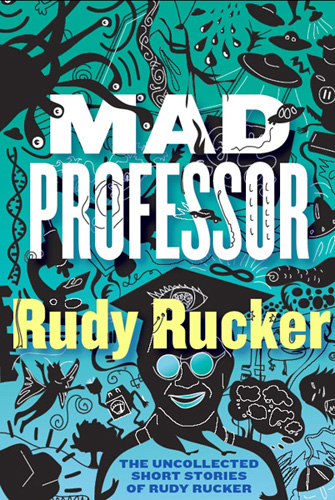
[The Mad Professor cover art and design is by Georgia Rucker Design.]
A point discussed in Skrbina’s Panpsychism in the West is that if you’re not careful, advocating panpsychism becomes simply a matter of watering down your notion of "mind" to apply to objects. But, with Skrbina, I want to claim that it’s a real sensual mind that you’re talking about in that rock, that pen, that finger, that dust mote, that hair, that napkin torn in half (two minds now). A materialist might say, hah, there’s no content to such a claim, but I feel that I demonstrated how it really would feel to talk to objects in my science-fiction story, “Panpsychism Proved” which appeared in no less august a journal than Nature magazine. And to think they dared call me mad! Oh, by the way, my story also appears in my anthology, Mad Professor. Here’s a free PDF of the story —I put it online for you just now.

[Goosie the finger-puppet is alive.]
The scientist-philosopher Gustav Theodor Fechner was a fascinating guy. He liked to talk about the daylight view versus the nighttime view. In the daylight view of the world, everything is flooded with soul and life. In the nighttime view, the world is dead, dark, inhospitable, and we sentient and living beings are but tiny firefly sparks. Not too many of his books have been translated into English, but here’s one of them that I found online, On Life After Death, from Google Books.
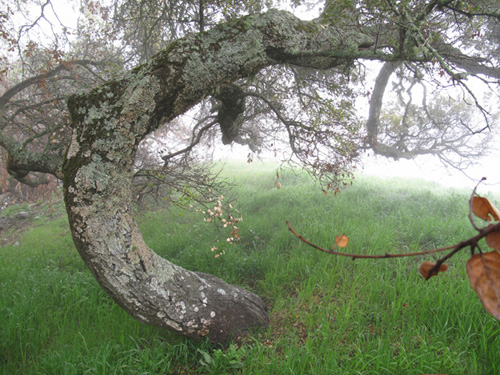
[This Big Sur tree is conscious.]
Finally, here’s a quote from the philosopher William James’s Pluralistic Universe online , describing Fechner’s work:
For him the abstract lived in the concrete, and the hidden motive of all he did was to bring what he called the daylight view of the world into ever greater evidence, that daylight view being this, that the whole universe in its different spans and wave-lengths, exclusions and envelopments, is everywhere alive and conscious… The original sin, according to Fechner, of both our popular and our scientific thinking, is our inveterate habit of regarding the spiritual not as the rule but as an exception in the midst of nature. Instead of believing our life to be fed at the breasts of the greater life, our individuality to be sustained by the greater individuality, which must necessarily have more consciousness and more independence than all that it brings forth, we habitually treat whatever lies outside of our life as so much slag and ashes of life only; or if we believe in a Divine Spirit, we fancy him on the one side as bodiless, and nature as soulless on the other. What comfort, or peace, Fechner asks, can come from such a doctrine? The flowers wither at its breath, the stars turn into stone; our own body grows unworthy of our spirit and sinks to a tenement for carnal senses only. The book of nature turns into a volume on mechanics, in which whatever has life is treated as a sort of anomaly; a great chasm of separation yawns between us and all that is higher than ourselves; and God becomes a thin nest of abstractions.
==============
#10 Friday Night Music
(Posted on May 22, 2009)
(Rudy Rucker is a guestblogger. His latest novel, Hylozoic, describes a postsingular world in which everything is alive.)
Guestblog brings you a special Friday night music treat!
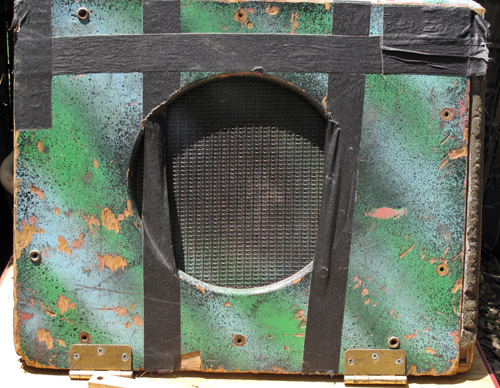
A playlist of NOFX videos! Yaaaar.
Best album of late? Easy. It’s NOFX and Rancid, BYO Split Series Vol III. My two favorite punk bands playing each other’s songs.
==============
#11 Gnarly Videos
(Posted on May 23, 2009)
(Rudy Rucker is a guestblogger. His latest novel, Hylozoic, describes a postsingular world in which everything is alive.)
All on their own, ordinary processes can make incredibly convoluted shapes. Consider, for instance the field lines of some magnets moving around each other, as shown in this video by Daniel Piker, who has a great blog of computational gnarl called Space Symmetry Structure.
William Rood has created a somewhat inscrutable—but mind-boggling—gnarl investigating page, just click on the screen-captured image below. It’s like flying an alien spaceship, with control buttons that you don’t understand. No matter, keep on clicking and gaze your fill.
Owen Maresh, another young investigator, is posting some exceedingly gnarly videos on his YouTube site. Here’s one that starts out calm—like an egg—but then goes ape via some folds through the subdimensions.
And finally, how about an explanation from the old Professor himself. Here’s my dada video: "What is Gnarl?" (with a narration that’s partly in imaginary Norwegian).
You just don’t get this kind of information anywhere except on BoingBoing!
==============
#12 Elephant Dung and More!
(Posted on May 24, 2009)
(Rudy Rucker is a guestblogger. His latest novel, Hylozoic, describes a postsingular world in which everything is alive.)
There’s an artwork by Chris Ofili in the San Franciso MOMA art museum just now. It includes a sequin-decorated ball of elephant dung, and stands on two more balls that rest on the floor.
It’s a pretty nice work.
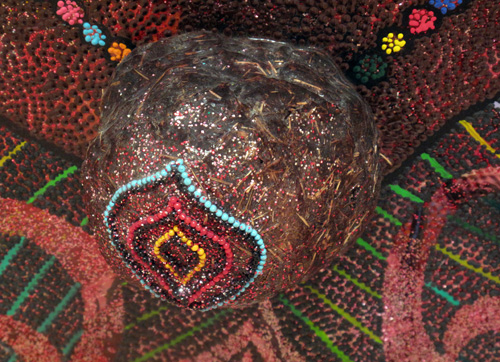
A Frank Stella illuminates the marble stairs.

I thought I’d heard of all the Abstract Expressionist painters by now, but here’s another one: Al Held. I really like the colors in this work.

==============
#13 AntWeb
(Posted on May 24, 2009)
(Rudy Rucker is a guestblogger. His latest novel, Hylozoic, describes a postsingular world in which everything is alive.)
I’ve always been fascinated by ants. Look at these guys taking apart a dead fly.
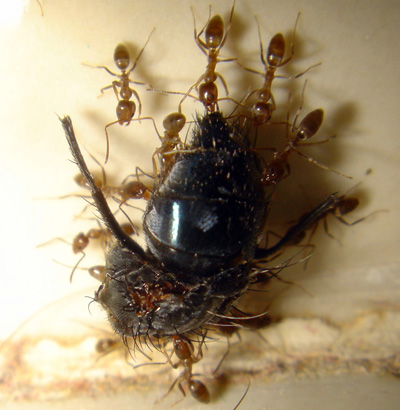
I found a (somewhat slow) website called AntWeb with a lot of ant pictures, like, of all 28 different genera of the ant subfamily called the ponerine ants.
There’s a striking similarity between ants and motorcycles, I’ve always thought—maybe there’s something about that rear ant bulge (known as the gaster) resembling a gas tank.

I like insects of all kinds, really. The ubiquitous roly-poly or pill-bug or woodlouse is a good pal.
In the early 1990s, when the notion of Artificial Life was big, I wrote a Windows program called Boppers: Artificial Life Lab, which incorporated a kind of virtual ant farm. I did the work at Autodesk, and now you can get the program as a free download.
In my usual "transreal" fashion (here’s an essay called "A Transrealist Manifesto" that explains that word), I wrote an SF novel about my stint at Autodesk, including some virtual ants that take over the world.
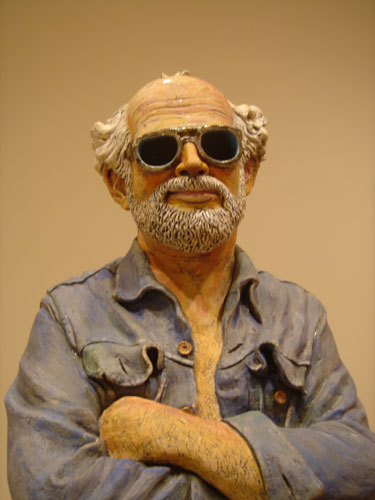
[California artist Robert Arneson’s ceramic sculpture self-portrait, “California Artist,” in which the dark lenses of the sunglasses are in fact holes. (I think he did this as an in-your-face gesture towards his critics, saying something like, “You say I’m an airhead, but can you make a sculpture like this? And can you fathom the meaning of Emptiness?”)]
I just noticed that on Google Books you can find part of the text of my Autodesk ant novel, The Hacker and the Ants, Version 2.0. Why 2.0? Well, the book first came out in 1994, and when I republished it in 2003, I upgraded some of the tech and gave it a slightly happier ending.
==============
#14 Clouds
(Posted on May 25, 2009)
(Rudy Rucker is a guestblogger. His latest novel, Hylozoic, describes a postsingular world in which everything is alive.)
If it was for some reason hard to see clouds, can you imagine how much people would pay for the privilege? Like, if there was only one spot on Earth that had clouds, everyone would be going there and having these big spiritual experiences just from seeing the clouds.

This is a cloud I saw in Big Sur. We get so much beauty for free in life.
I always enjoy photos of weird and unusual clouds, and I found a cornucopia of them on the over-the-top image site, "Dark Roasted Blend".
=============
#15 The Subdimensions
(Posted on May 25, 2009)
(Rudy Rucker is a guestblogger. His latest novel, Hylozoic, describes a postsingular world in which everything is alive.)
I can’t put my finger on a really good link to the word "subdimension" in Golden Age SF and comics, maybe some readers can come up with it. It’s basically a place-holder word, a liguistic MacGuffin, used to fill in for any type of weird science that happens to be needed. But I’ve always wanted to visit the subdimensions.

Experientially, I think of going into the subdimensions as being something like SCUBA diving…here’s a photo of a guide, my big brother Embry and me diving near Yap Island in Micronesia.
In recent years I decided to retrofit the word “subdimensional” and use it to apply to a hypothetical cosmos that lies “inside the Planck length,” in a sense that I’ll explain at the end of this post.
I introduced this SFictional usage three yeares ago in a story with Paul DiFilippo, “Elves of the Subdimensions,” which is still online in issue #1 of my webzine Flurb.
And I used it again in my novel Postsingular. You can either buy the paperback or download a free Creative Commons PDF release from my site for Postsingular. Here’s a drawing from my online working notes for the novel (these notes are also online my Postsingular site).
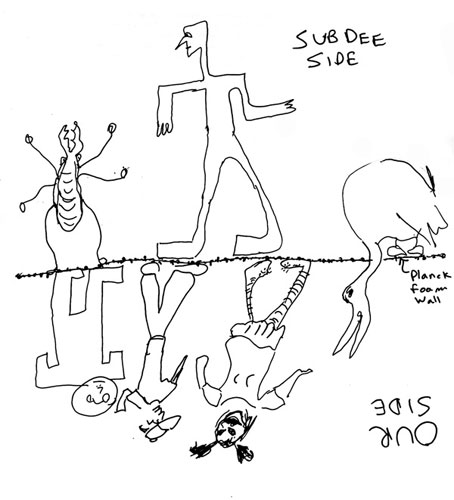
The beings who live in the subdimensions are called "subbies," and generally speaking, you’re better off not having any dealings with them!
It’s always nice have some kind of scientific justification for what I write about, and, by way of justifying the reality of the subdimensions, I found the following passage in Michio Kakau, Parallel Worlds, where he discusses a 1984 theory of “string duality” ascribed to Keiji Kikkawa and Masami Yamasaki. String duality allows for interesting physics below the Planck length (which is roughly a quadrillionth of the diameter of a proton). The Planck length becomes something like an interface between two worlds. As Kakau puts it:
Let’s say we take a string theory and wrap up one dimension into a circle of radius R. Then we take another string and wrap up one dimension into a circle of radius 1/R. By comparing these two quite different theories, we find that they are exactly the same. Now let R become extremely small, much smaller than the Planck length. This means that the physics within the Planck length is identical to the physics outside the Planck length. At the Planck length, spacetime may become lumpy and foamy, but the physics inside the Planck length and the physics at very large distances can be smooth and are in fact identical.
==============
#16 Hylozoic Released Today
(Posted on May 26, 2009)
(Rudy Rucker is a guestblogger. His latest novel, Hylozoic, describes a postsingular world in which everything is alive.)
My new SF novel Hylozoic starts shipping today.
Hylozoic continues the story of my previous novel Postsingular, although it’s self-contained enough that you can read it on its own.
What I was after in these two books was to tackle the notion that our world is going to (or already has) changed in a very extreme way, due to the presence of increasingly powerful computers—this notion is what people often term "the Singularity," a usage introduced by SF writer Vernor Vinge in a classic 1993 talk.
A few SF writers were worried that we wouldn’t be able to write about the future after a technological singularity, but Charles Stross’s 1995 novel, Accelerando, blew the doors off this fear. Charlie just up and does it, brings on the singularity before our eyes.
Emboldened, I wrote my own version of a world after the singularity, that is, Postsingular. In my take, computation migrates out of man-made devices and into natural processes. Everyone has something like a web browser in their heads, telepathy becomes real, and even teleportation becomes possible. And then a universal memory upgrade takes hold…and everything wakes up.
And that’s where Hylozoic starts.
The story is (kind of) represented in a triptych of three paintings that I did while I was working on it. In the left panel, we see our heroine Thuy Nguyen noticing that there some nasty little beings in the subdimensions. In the central panel, a flying alien manta ray is about to rescue Thuy and her boyfriend Jayjay Jiminez—the background patterns indicate that the air itself is alive. In the right panel, Thuy and Jayjay fly up to a higher level of reality in order to fix things up.
[The Hylozoic Triptych. Click on the image to see a larger version.]
If you want to know a little more about the book, you can access my Hylozoic Writing Notes, online as a book-length PDF document containing the working notes for the book. I have numerous images in the document, and internal and external links as well. (If the file fails to open for you, this could mean that someone else is currently opening it, and the server is overloaded—try again another time and mabye save the file to your local drive so you can peruse it at leisure.)
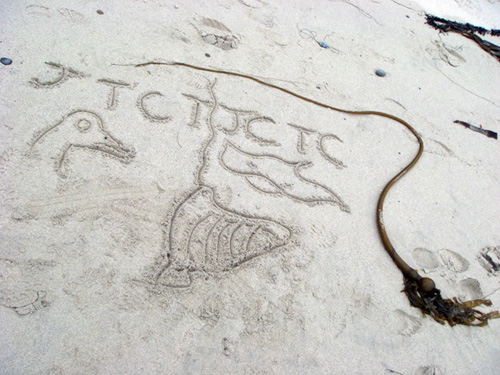
And finally, here’s a picture from the Hylozoic Writing Notes, of a plot diagram that I made on the sand at Big Sur. You can see an evil alien Peng bird on the left, the Magic Harp in the middle, and a Hrull flying manta ray on the right. The letters indicate the chapters’ point of view, which alternates among Jayjay, Thuy, and Chu.
==============
#17 Wolfram|Alpha is Live
(Posted on May 26, 2009)
(Rudy Rucker is a guestblogger. His latest novel, Hylozoic, describes a postsingular world in which everything is alive.)
Six weeks ago, I interviewed Stephen
Wolfram about his intriguing new online tool Wolfram|Alpha. And now Wolfram|Alpha is live. Give it a try…it’s not exactly a browser, it computes facts and images based on the browser data that it retrieves, and presents the new info on web pages it designs on the fly.

If a word isn’t in the Wolfram|Alpha database—like the word "Boing"—the answer you get may be a bit of a surprise. But the expectation is that over time Wolfram|Alpha’s abilities will grow.
==============
#18 Cellular Automata at Work
(Posted on May 27, 2009)
(Rudy Rucker is a guestblogger. His latest novel, Hylozoic, describes a postsingular world in which everything is alive.
I’ve been interested in cellular automata (CA) for many years, and I helped program two different free, downloadable CA software packages for Windows: Cellab and Capow.
If you just want a peek at these scuttling graphics, try Mirek Wójtowicz’s Java-based MJCell program, viewable in your browser.
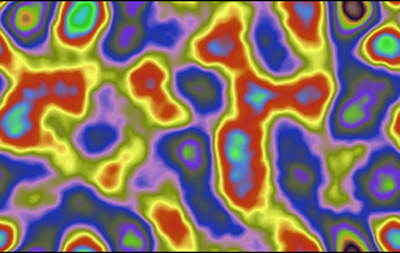
In the 1980s, my fellow cellular-automatist John Walker and I used to believe that CAs were poised to take over the worlds of video, fabric, and game effects. But the revolution is a little slow in coming…
At least, as I discussed in a "Gnarly CAs" article in Make magazine last year, my former student Alan Borecky indeed managed to make a CA dress for his wife, Donna. And I keep noticing that a lot of the fabrics that I see people wearing these days could easily be designed by CAs.

Nosing around for further evidence for the advance of CAs, I found some mildly heartening signs. The blog Code-Spot has a tutorial on using CAs in games.
The book Core Techniques and Algorithms in Game Programming has a little bit about using CAs to generate fire.
And cellular automata have played a role in both SimCity and Spore.
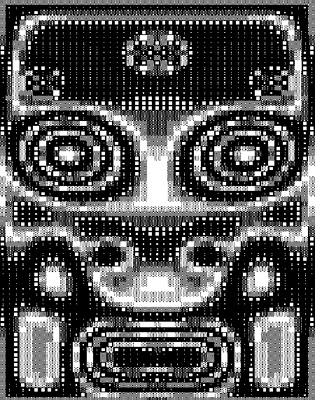
I’ve long thought that digital musicians should lean more heavily on chaotic effects so as to avoid roboticity. KVR Audio Damage has released a CA-based device called Automaton:
A glitch plug-in that uses a unique game of life style sequencer…capable of adding subtle, seemingly random fills and humanizing effects, but if you like, you can crank the sequencer up to eleven, and watch as your digital audio workstation becomes a petri dish while Automaton makes complete hay of the track you’ve inserted it to.
==============
#19 Street Photography
(Posted on May 27, 2009)
(Rudy Rucker is a guestblogger. His latest novel, Hylozoic, describes a postsingular world in which everything is alive.)
I’ve always admired the work of great street photographers like Gary Winogrand.
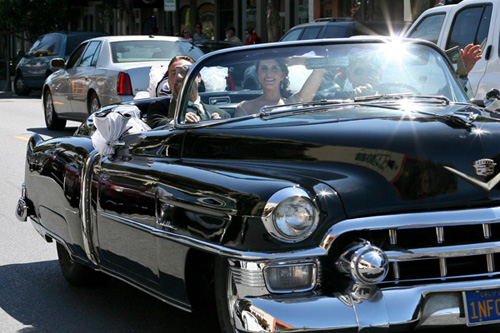
This is a photo I happened to take myself a few months ago. To see quite a few more (by other people) just search Flickr for "street photography".
Looking online, I’ve found endless discussion about the techniques and ethics of street photography. This discussion thread on Photo.net is interesting. And this PDF book by Chris Weeks, Street Photography for the Purist is quite rich, with illustrated intros by several other street photographers. I found both these links, by the way, in the Wikipedia article on Street Photography.
==============
#20 Monkeybrains Can Antenna
(Posted on Posted May 28, 2009)
(Rudy Rucker is a guestblogger. His latest novel, Hylozoic, describes a postsingular world in which everything is alive.)

My son, Rudy Rucker, Jr., and his business partner Alex Menendez run Monkeybrains, an independent ISP (Internet Service Provider) in San Francisco. As well as more conventional clients, they use their two gigabytes-per-seconds to host such off-beat sites as Rotorbrain’s hardware hacking blog, and the site for the Cyclecide Heavy Pedal Bike Rodeo.

Here’s a video interview of Rudy and Alex on the tenth anniversary of Monkeybrains..discussing how an indie internet biz can stay afloat.
Rudy’s latest project involves building his own wireless can antennas, as described on Dorkbot.
==============
#21 Flamed Cars
(Posted on May 28, 2009)
(Rudy Rucker is a guestblogger. His latest novel, Hylozoic, describes a postsingular world in which everything is alive.)
I’ve been fascinated by cars with flames ever since I was a kid poring over my big brother’s hot rod magazines.
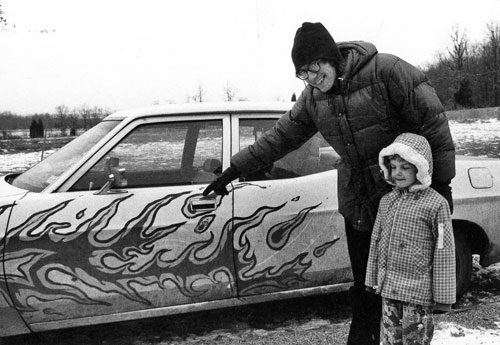
[Photo by Don Marritz]
In 1973 I had a fairly generic white Ford that I painted flames on my myself. Here’s a picture of me with the car and my daughter, Georgia, who’s now a graphic designer of such books as the best-selling Twilight Movie Companion.
I did a hand-painted, amateur job on my flames— not at all the way the pros do it—but it was fun. And, despite the dire warnings of my friends, I was still able to sell the car when I moved.
A couple of weeks ago I went to the Show and Go car show in Riverside, California, which got me excited about flames all over again.

I found a quintessential flame-car photo on the web today, it’s this Merc Lead Sled shot, and it appears on John Filiss’s "Serious Wheels" site, among other gems in the "Mercury Custom" section…just look under "M".
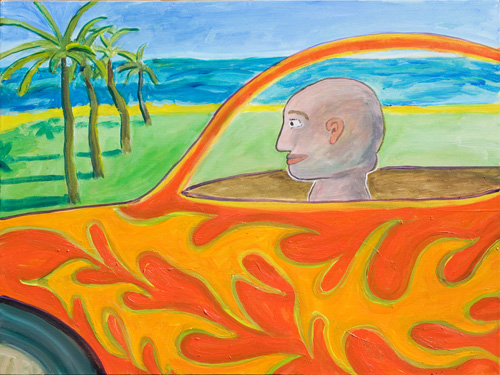
Today I finished a painting on this theme, "Man in Flame Car." It’s hard to pin down the guy’s mood. (More info on my paintings page.)
==============
#22 Swiss Writing Knife
(Posted on May 29, 2009)
(Rudy Rucker is a guestblogger. His latest novel, Hylozoic, describes a postsingular world in which everything is alive.)

Recently my jeweler daughter, Isabel, made me a great “Swiss Writing Knife” with symbols of seven of the things I’m interested in: A Zhabotinsky scroll (for cellular automata), the Mandelbrot set (for fractals), a robot, A Square (for the fourth dimension), Infinity, a UFO, a Cone Shell (for diving, cellular automata, universal automatism, and SF). It’s gold-colored metal and the little “blades” swing in and out, with the icons in silver-colored metal riveted on.
I tend to adjust the knife according to what kind of story or novel I’m working on, and I keep it by my keyboard as a good luck amulet, or an embodied muse.

Isabel’s business, Isabel Jewelry is in Pinedale, Wyoming, and she makes most of her sales over the web. One of her customers was in fact Boing’s own Cory Doctorow, who had her custom-make a pair of crypto-device wedding rings.
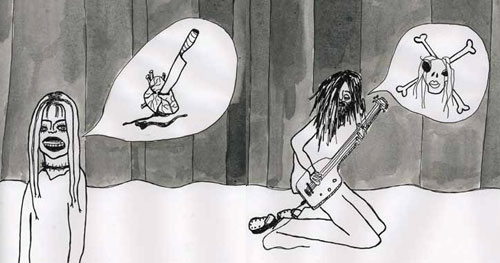
As a sometime zinester, Isabel has a cool drawings site as well—check out her "Get Back" story about thongs. Isabel’s graphic novel, "Unfurling: The World’s Longest Comic Strip," will be on display this November at the SOMArts Gallery in San Francisco, all four hundred or so feet of it!
==============
#23 Friday Night Zappa
(Posted on May 29, 2009)
(Rudy Rucker is a guestblogger. His latest novel, Hylozoic, describes a postsingular world in which everything is alive.)
Sooo…it’s Friday night again.
How about a playlist of thirty or so videos by Frank Zappa!
We miss you, Frank.
==============
#24 Weird Science
(Posted on May 30, 2009)
(Rudy Rucker is a guestblogger. His latest novel, Hylozoic, describes a postsingular world in which everything is alive.)
Looking back over the advance of physics over the last two hundred years, it’s staggering to realize how much our world view has changed. As a science fiction writer, I’m always trying to imagine how much more things might change in the coming two centuries. The really hard thing to anticipate is the completely game-changing advances that occur every so often.
My sense is that, for one thing, we won’t be using chip-based computers in two hundred years—any more than we use mechanical calculators now. That’s why, in my recent novels Postsingular and Hylozoic, I’ve been speculating about a world in which our computations escape from our machines and filter into our ordinary matter.
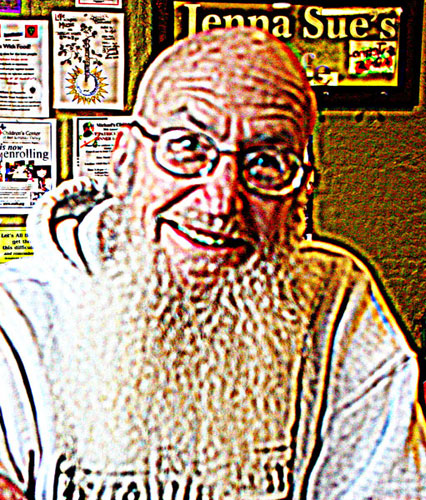
Nick Herbert is one of my favorite offbeat physicists. One of his papers in particular is something I’ve thought about a lot over the years: “Holistic Physics, or, An Introduction to Quantum Tantra.” Here Nick argues that our conscious minds display some of the same features as quantum mechanics. When we’re not thinking about anything in particular, our thoughts evolve in a continuous, multi-universe kind of way—but when we focus on something, we carry out something like the quantum collapse that characterizes the process of measurement.
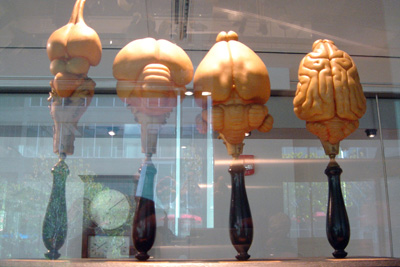
[Brain models from the Collection of Historical Scientific Instruments at Harvard University.]
As I’ve been saying, I think it’s at least in principle possible that the quantum computations in ordinary matter might be capable of carrying out these same kinds of processes—which we normally associate with living, conscious minds. And Nick’s paper helps you to think about this idea.
David Deutsch wrote a deep and technical paper about the topic of computation in arbitrary pieces of matter, called "Quantum theory, the Church-Turing principle and the universal quantum computer."
The basic idea is that quantum mechanical systems can act as universal computers, and it’s generally believed that any universal computer can emulate a human mind (given the right program, and, aye, there’s the rub).
One of our big problems is that we still have such an imperfect notion of how to build a software system that’s like a human mind. The best idea along these lines that I’ve seen in the last few years is in the book On Intelligence, by Jeff Hawkins and Sandra Blakeslee.

Two more rich sources for futuristic ideas.
(1) The arXiv.org site—for instance look at their New Papers on Cosmology and Extragalactic Physics page. It blows my mind that you can so easily access all these wild new papers, easily readable in PDF form. Even if, for the average person, a lot of the writing is incomprehensible gibberish (like the backwards neon sign shown above), you can skate through and pick up some great concepts and buzzwords.
(2) The physicist John Baez’s pages. Baez is a deep thinker and a gifted popularizer, adept at imparting the true strangeness of this world.
It’s liberating to realize that, as always, we’re very much on the edge of knowing what’s really going on.
==============
#25 Silicon Valley As I Found It
(Posted on May 31, 2009)
(Rudy Rucker is a guestblogger. His latest novel, Hylozoic, describes a postsingular world in which everything is alive.)
This has been an exciting—and exhausting—two weeks, guestblogging for Boing. I don’t see how the regular Boing bloggers get anything else done.
As a parting offering, I’d like to share some of my reminiscenses about Silicon Valley as I found it when I moved here in 1986.
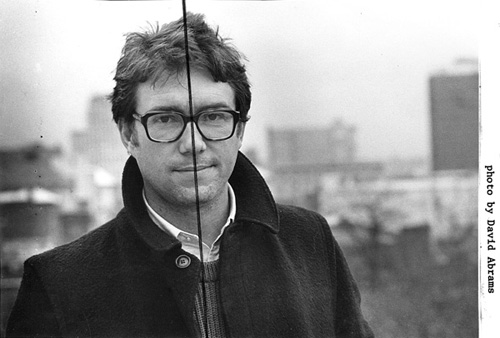
[Me in 1985, photo by David Abrams. I don’t remember exactly why I drew the line on the photo…something about distinguishing between the two halves of the brain, that is, the writer side vs. the programmer side.]
A little background. Over the last year I’ve been working on a memoir called Nested Scrolls, and I’m hoping to find a publisher for it soon.
The memoir’s title has to do with two things: (a) my favorite kinds of cellular automata rules make seething scroll-like patterns that nest together like layers of scrolls, and (b) you can think of writings as being scrolls, and to the extent that a multilevel written work refers to other works, it’s a nested scroll.
What I’m posting here is Chapter 10 of Nested Scrolls, called "Hacker"—and this particular chapter is about diving into the Bay Areas scene of yore. Here’s an excerpt:
In 1987 I attended an annual event called the Hackers Conference. Remember—hacker was still a good word, so these guys were Silicon Valley programmers and hardware tweakers. Some of them were even fans of my books. The fact that I’d written a science fiction novel called Software had put me on the hackers’ radar.
I brought my computer with its CA axe [that is, its hand-made cellular automata accelerator card from Systems Concepts labs], and I stayed up all night with the hackers, drinking beer, smoking pot, and admiring our weird screens. Although Hollywood often depicts hackers as nerdy, inhibited types, that’s not generally accurate. It’s more common that hackers are like hippies or acid freaks or mad scientists or car mechanics.

And with that I’m outta here. Rock on, y’all, and, if you liked my posts, come see me at Rudy’s Blog.










